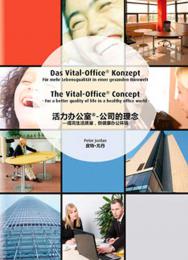Stress load model
The individual influences that act upon a person are certain characteristics of different stresses. This means that many small partial stresses caused by office appliances, work processes and the working environment have their effect on the worker. The sum of all these small partial stress loads constitutes the total stress load.
Since the office environment usually does not have a partial stress that immediately causes significant harm to one’s health, it is important to recognize the total stress load and this also over a longer period of time.
Ergonomic polarity
The human being in the workplace creates a contradiction for himself.
On one hand, humans need social interaction. To be seen and recognized (feedback) is a basic need that is required for healthy personality development. On the other hand, the average office worker wants the greatest amount of privacy possible. He would prefer having an enclosed office for the best possible concentration, and yet at the same time he wants optimum conditions for communicating with coworkers.
It is therefore not wisest to force a 100% solution for one side; rather, it is more effective to strive for a 60/40 solution.
Branches of Ergonomics
Usually sales people use parts of ergonomics, which they need to sell their product. But we should have an overview of all interlinked factors. Science names the following branches. ALL of them needs consideration to facilitate an ergonomic office and workplace.
- Anthropometrics: to adapt and adjust items to the human body measurements. (form and size of items, adjustability, .. )
- Physiology: to adapt working conditions to human beings.(lighting, air-conditioning, noise, .. )
- Psychology: to create a comfortable environment.(colors, arrangements, flowers, .. )
- Sociological: covering the needs of group membership
- Informatics: design of Info-devices(see, hear, touch and feel .. )
- Organization: organization of work-place tasks.
- Security: prevention of injuries and long term health problems.
Hygiene, comfort and personal appreciation
The table-top edge is an important point from an ergonomic viewpoint. It shows us the value of our work quite directly. In accordance with the principle
“The quality of our surrounding work environment determines the quality of our work.”
The table-top conveys to us how attentively and carefully we are required to do our job. For example, you have to be less attentive at a plastic edge than at a solid wood edge.
- What is your personal appreciation - Is this equal to the amount your buying department is willing to spend for your desk?
- Don’t fool yourself. Exactly this appreciation and this quality is reflected on you every day you spend at your desk.
Since we are constantly in direct contact with the table edge, the shaping of the edge with respect to its hygienic qualities must be assessed. For instance, with traditional chipboard with plastic edge banding, the joint develops very rapidly into unhygienic dirty joint, in particular, because the adhesive used is water-soluble and therefore absorbs the sweat from the surface of the hand.
In practice, unfortunately, not enough attention is given to the shaping of the table top. We are in direct contact with the edge with our underarms all day, the whole week and finally the whole of our working lives.
High-quality table tops manufactured from homogenous material with smoothly profiled edges combine hygiene, comfort and appreciation.
Conclusions:
- An ergonomic workplace design must be carried out conscientiously for each project and each office individually. At the same time, all branches of ergonomics must be taken care off.
- You cannot talk yet about an ergonomic workplace simply by obtaining so-called ergonomic furniture and office chairs. The basic human needs in the psychological field, for example, privacy, communication and integration, are just as important and can only be taken care off through ergonomic professional and conscientious office planning.
- The quality of our surrounding work environment determines the quality of our work – thus he table-top conveys to us how attentively and carefully we are required to do our job.
Downloads:
A meticulous and holistic design of the working environment, however, can promote creativeness and significantly contribute to the wellbeing of body and mind. This design also promotes
...










 /a>
/a>
 /a>
/a>
 /a>
/a>
 /a>
/a>
 /a>
/a>
 /a>
/a>
 /a>
/a>
 /a>
/a>
 /a>
/a>
 /a>
/a>
 /a>
/a>
 /a>
/a>
 /a>
/a>
 /a>
/a>
 /a>
/a>
 /a>
/a>
 /a>
/a>
 /a>
/a>
 /a>
/a>
 /a>
/a>
 /a>
/a>
 /a>
/a>
 /a>
/a>
 /a>
/a>
 /a>
/a>
 /a>
/a>
 /a>
/a>
 /a>
/a>
 /a>
/a>
 /a>
/a>
 /a>
/a>
 /a>
/a>
 /a>
/a>
 /a>
/a>
 /a>
/a>






